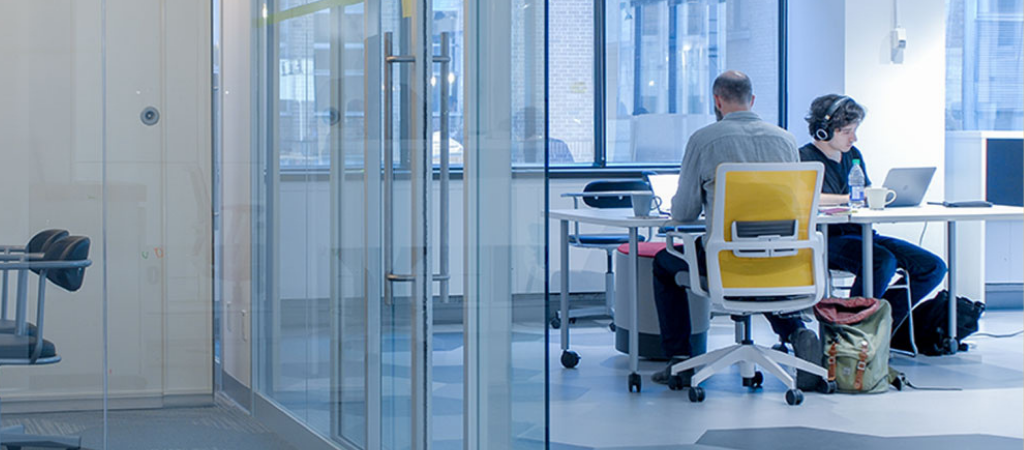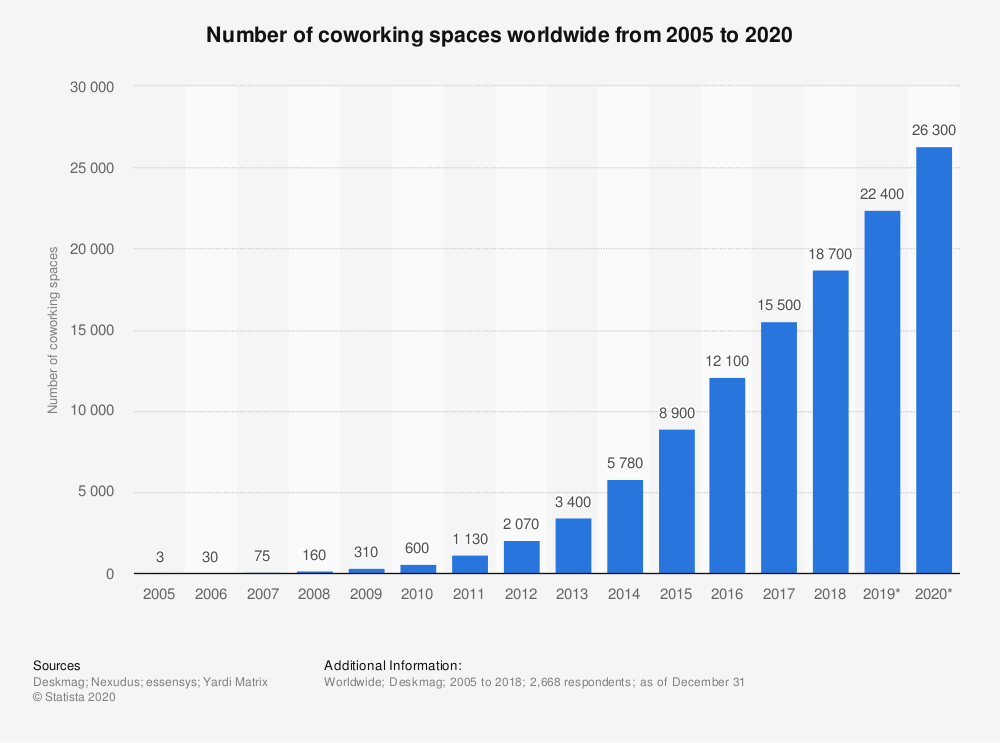
From meetings in the office to Zoom calls in our bedrooms, the COVID-19 pandemic has had a massive impact on our daily routines and changed our perception of the workplace. Through an analysis of both pre-pandemic trends and current employees’ sentiments, we explore what the lasting impacts of these new dynamics might mean for the future of the workspace?
The idea of a new normal is often brought up when discussing how COVID-19 has impacted our lives. This implies that the way we used to perceive normality no longer reflects the realities of today. After almost one full year of hybrid work, dominated by makeshift home offices and virtual communication, one thing is for sure: where and how we work, especially as it relates to offices, is unlikely to return to the “normal” of old.
Professor of Business at NYU Stern, Scott Galloway, argues in a recent book on the post-COVID-19 world that while the pandemic has initiated some trends and altered others, its most enduring impact will be one of an accelerant. So, what trends can we see in how employees and employers understand the workspace, and how have they accelerated during the pandemic?
This article will be the basis for a Brown Bag Lunch presentation this Thursday (11th of February 2021).
Pre-pandemic trends
In the ten years before the pandemic, Canada’s unemployment rate dropped to a record low of 5.56%, leading to an employee-driven job market. This created a need for employers to develop positive work environments and cultures as well as invest in perks and training programs to retain and attract employees.
The late 2010s saw a steady increase in remote and flexible work options as prioritizing wellness and mental health rose as a priority for employers. This coincided with a rise in digital telecommunications and cloud-based solutions which allowed employees to stay in the loop with their teams, even when away from the office. Yet, by late 2018, only 13% of Canadian workers were doing any form of scheduled work from home, according to Stats Can, representing only a drop in the bucket compared to the dramatic shift which would take place last year.
Acceleration into a new normal
March 2020 brought the dawn of a new reality as an explosion of local COVID-19 cases in Canada and globally forced workspaces to shut down indefinitely. Between February and the end of March, Canada lost over 1 million jobs while a further 2.1 million people had their work hours cut. By the week of March 22nd, while Prime Minister Trudeau told folks to “go home and stay home,” up to 39% or 6.8 million Canadians were unexpectedly working-from-home. This transition to remote work was mostly possible for workers in management, natural and applied science, research and education, business, finance and administration, while heavy employment losses occurred in public-facing jobs in the service sectors.
For those whose homes became the new office, the work-from-home reality required adjustments to recreate a productive daily routine. Different people were faced with various challenges as families felt the burden and relief of having full houses every day, while those living in small city apartments faced the reality of potentially sleeping and working in the same room.
However, for many Canadians, working-from-home highlighted how a more fluid work culture could benefit their mental health and productivity. Over 12.6 million Canadians previously reported an average 24-minute commute to work, adding significantly to daily stress. Additionally, working-from-home made it easier to promote a healthier work-life balance allowing employees to take more control over the schedule of their days while still completing their work. Remote work also allowed for location independence, reducing geographical boundaries to accessing work opportunities, especially for those living in rural communities, while also decoupling the need to live full-time in a specific place for work.
In a Canadian study conducted just two months into the pandemic, more than 60% of people who had been forced to work-from-home said they realized it wasn’t necessary to go to the office to do their job, while 55% said their work-life balance had improved. Notably, 85% of survey respondents said that when office work returned, they wanted to work-from-home more frequently.
While not without its flaws, the working-from-home experiment has positively impacted much of the workforce. In July, an Angus Reid study found that 44% of workers anticipated returning to a mix of home and office-based work post-pandemic, with a further 20% expecting to stay fully remote. This shift in preference to a hybrid model was affirmed by an end-of-year study conducted by online company ClickMeeting which found that 56% of Canadians said they enjoyed hybrid work and would prefer a hybrid model of home and office employment.
Perspective from a hybrid worker
Emma Bugg is a Communications and Campaigns Manager for Evidence for Democracy, an education and research organization in Ottawa. Like many others, Emma and her team quickly transitioned into working from home when the pandemic began. However, by the time we caught up with her, Emma had begun engaging in hybrid work, splitting her workdays between home and her office space at Impact Hub Ottawa. She shared her experience and perspective regarding the evolution of the workspace during the pandemic.
The initial change to working from home brought many benefits:
There are so many luxuries from working at home. Simple things like being able to do my laundry [during the work day], or cook myself a fresh lunch during the day.
But like many young office workers, the constraint of living and working in a confined space began to take its toll, so coming back into Impact Hub Ottawa’s co-working space a few days a week provided welcome relief:
“I’ve been coming Monday and Friday to the office [which are] the days I struggle the most with focus… and so something as basic as coming into the office is helpful. The change of scenery is simple. The home office is my bedroom, is my gym, is my everything, which hasn’t been nearly as bad as I thought it would be, but it is getting old. So it’s nice to get a change of scenery.”
 Emma outside her Evidence for Democracy office in the Impact Hub Ottawa coworking space
Emma outside her Evidence for Democracy office in the Impact Hub Ottawa coworking space
In thinking about the future of the workspace, there is no doubt for Emma that a transition to hybrid work is here to stay:
The ideal would have half time here and half time at home. I really like having the flexibility, but I also miss having in-person meetings and having a different place to go during the day.
This new reality clearly challenges the traditional view of big office buildings with 9-5 office work five days a week, and for Emma, a transition back from the new normal of office work is unlikely:
I feel like the traditional office building is dead. I don’t see why we would return to that when we’ve learned through the pandemic that everyone working in separate offices at home is no different than everyone working at the office in different offices. Other than the change of scenery or the ability to meet in person.
I think that spaces like [Impact Hub Ottawa], or offices where the team is more fluid and open, are going to make much more sense moving forward.
Looking forward – The rise of hybrid work
While the pandemic has led to unimaginably difficult new realities for many people impacted by the virus, it has also provided us with a new lens from which to see the workspace. Many employees no longer see the benefits of spending five days every week in the office, and the benefits of hybrid work could see an increase in both productivity and wellbeing.
Such a transition in mindset could have considerable consequences for the economies of scale for office rental costs. By the end of 2018, Canada experienced a country-wide commercial property market boom with vacancies down to 11%, while in 2019, Ottawa’s thriving economy led to an office vacancy rate of just 7.5%, a ten-year-low both in the suburbs and downtown.
With more than 50% of office-working Canadians predicting they will transition to hybrid work or remain remote after the pandemic, it is unlikely that Canada’s commercial property boom will be sustained. Instead, many small to medium-sized businesses and start-ups will likely be looking for more flexible working options.
An opportunity for coworking spaces
As we’ve explored, the pandemic has accelerated existing trends in remote work. The world over, coworking has seen a dramatic rise over the past decade, due to an increase in remote work and self-employment. While the pandemic provided many challenges to these spaces, those who are able to stay open will likely witness a substantial post-pandemic increase in demand.

Coworking spaces seem ideally suited to cater to small and medium-sized businesses as well as self-employed contractors and remote workers. They offer much more flexibility in renting space on a month-to-month basis rather than yearly, like larger commercial buildings, and at a much more affordable price.
Coworking spaces are also tailored to the needs of a hybrid work system by offering options for dedicated offices and full time and part-time coworking options. Additionally, the amenities that come with coworking spaces, such as high-speed internet, meeting and conferencing rooms, are tailored for the future of flexible workspaces.
Finally, one of the experiences most lacking has been a social connection. Coworking spaces that allow members to network and collaborate in a clean, accessible and well-spaced environment are likely to thrive post-pandemic world.
The bottom line
With vaccination levels in Canada expected to cover most of the country by the end of 2021, returning to a more familiar normal is fast approaching. While our research can only help us predict the future of the workspace, it is clear that flexible hybrid work will be a staple.
The main questions will revolve around how companies, especially those with large workforces who have transitioned to working from home, will navigate a new work environment, where more than half of employees desire more flexibility in how and where they work. This provides a considerable opportunity for coworking spaces that are purpose-built to cater to the needs of hybrid work. Those who are able to differentiate themselves and provide social environments suited to collaboration will be in high demand.
Want to be part of a community?